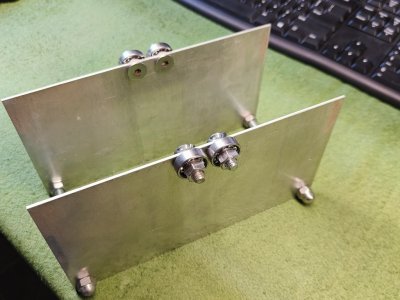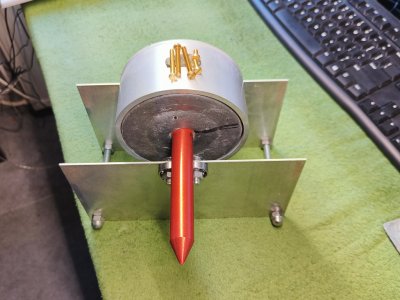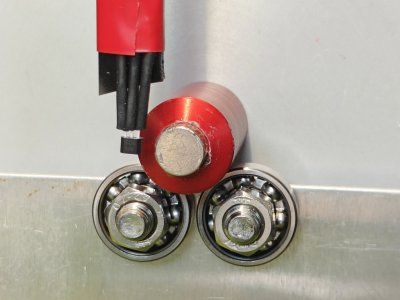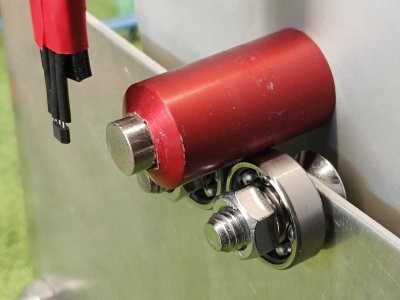In Brief:
In discussions with a.o. prof. Matthew Cartmell it became clear that unbalance in the bob (asymmetric mass distribution) may contribute to ellipse growth.
To investigate this I have made a simple device to inspect and improve the balance of my bob.
The setup also allowed me to do a mesurement of the (a) symmetry of the field strength of the bob's magnet.

Fig 1. The device consists of 4 small ball bearings mounted on a supporting frame.
The nature of the frame is not critical, but it must be stable.
The critical parts are the ball bearings, they must have a very low friction. The bearings I had at hand originally had a plastic dust cover and were lubricated with thick fat. I removed the dust covers and dissolved the fat in a cleaning agent and cleaned them with compressed air, to remove possible dust particles.

Fig 2. Balancing the Bob.
I did it the following way: I gave the bob a small rotational push and observed where it stopped and if it reversed direction after stopping. Then I added some non-magnetic mass on the top. I used some brass screws and a sticky putty. (I think used chewing gum will do also) I added, removed or displaced the extra mass until the bob would stop in any position coming from both directions, without reversing its direction before the final stop.
I ended up with 13 gram of mass attached to the outside of the bob at 6 cm radius.
I then drilled away ca. 14 grams of the lead on the opposite site of the extra mass, close to the outside of the bob, bit by bit, until the same stopping behaviour was reached. (here I found that drilling in lead is not a funny job. it sticks very much to the drill)
Limitations of this method:
It works only with a cylindrical bob with a stem protuding from top and bottom.
Another limitation is the remaining friction in the ball bearings and possible roughness of the stem.
Will it produce a perfect symmetry?
Not guaranteed. This method symmetrises the mass distribution in a plane perpendicular to the centerline of the bob. There stil can be asymmetry in a plane angled to the center line.
Or, the bob might not be circular on its outside.
Will that be a problem?
Not necessarely. To my opinion the mass distribution itself is not important, but it can lead to the bob taking an oblique or leaning position, which leads to a directional dependency of the air friction.
To say it in an other way: Think a bob with a very asymmetric shape and mass distrubution swinging in vacuum. Will that be a problem?
Results of the pendulum behaviour after this improvement:
Fig 3. Amplitude of the minor axis plotted against the precession angle, before and after the balancing action.
Data are from aug 21-25 and from sept 11-15.
No systematic difference has been found. The graph shows an asymmetry of the minor axis' amplitude which I do not understand at this moment.
For me it is now likely that the large minor ampliude of my pendulum is not caused by an unbalance in the bob.
If other causes have been found and eliminated a remaining unbalance may become an issue.
Asymmetry of the bob's magnetic field.

Fig 4. Magnetic field probe near the lower stem of the bob.

Fig 5. Magnetic field probe near the lower stem of the bob.
The next day I realized that I could use this setup also to investigate the magnetic field of the bob, much like prof. Cartmell has done.
I mounted an AH35 analog magnetic field sensor (~1€ /pc) to a non magnetic bar and placed it at X = 8 mm and Z = -8 mm w.r.t. the tip of the bob. This is approximately the position where the wires of the drive coil sit. I rotated the bob to 8 positions and found a peak-to-peak deviation of 3% in the fieldstrength.
With the sensor on the centerline of the bob the deviation was less than 1 %.
What to do with this result?
At the moment nothing.
But it compares nice with the 6% prof. Cartmell found when he was selecting magnets for his bob. [Cartmell, Multiscale_Dynamics....]
Maybe the fact that I use a pile of 5 such magnets helps to improve the uniformity of the field.
And there will be an effect from the bearings and their fixation being of ferromagnetic material.